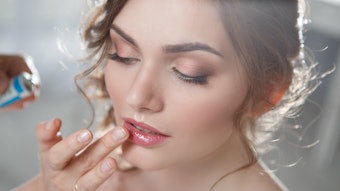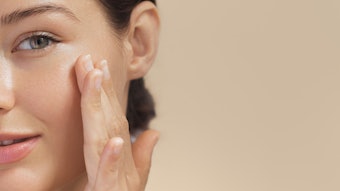
As a little girl of 3, I recall climbing up to my mother’s vanity and pulling out a beautiful crystal-encrusted lipstick case that a friend had just brought from France. I wanted the lipstick, which smelled of roses, within that case. I’ll never forget it. It was then that I must have realized the power of makeup. Not only did I love applying it to my lips, but the scent also sent me to the moon. A love of makeup was born within me, and it was the harbinger of recognizing that lipstick wasn’t just color—it held a world of magic.
Flash forward decades later … lipstick still captivates me; it is chock full of all kinds of good stuff for your lips and is getting more advanced in staying power and benefits. There’s new magic afoot here.
The quest for efficiency and youth
Currently the quest is for the ultimate in multitasking cosmetics, particularly in a culture obsessed with efficiency and youth. Consumers are seeking a means to get as much done as possible, while wanting to simplify and streamline. In fact, according to a recent NPD Group Inc. report, approximately 86% of makeup-users have used a makeup product that contains a skin care benefit in the past year. This idea culminates in personal care products that are a hybrid of convenience, results and color all in one. Herald the arrival of an amazing array of color treatment combinations and multitasking/multipurpose products, such as powders that finish makeup and act as sunscreens; primers with benefits for aging skin, oil absorption and sebum control; and tinted sunscreens. “[Combining color and skin benefits] is becoming a research and development necessity, and is already a consumer demand with significant point-of-product differentiation,” explains Casi Morris, owner and principle of Casi Morris Consulting, a Los Angeles-based independent consultant, developer and formulator of skin care and beauty products. “The economy has placed a burden on most Americans’ spending, so consumers have chosen to cut back on nonessential personal care products, such as eye shadows, primers and illuminators, and spend on items that necessitate a critical part of their daily regimen.”
This trend has been in effect for a number of years and is steadily taking over what could now be construed as commonplace makeup. “It started 10 years ago with an emphasis on anti-aging in beauty; with all the potions and serums available, it is only natural that color would want a piece of the pie. Pure color is a hard sell these days, but I really believe that skin care benefits should only enter into it when it makes sense,” explains Cristina Bartolucci, vice president of innovation at Roberts Cosmetics and co-founder of DuWop Cosmetics. This isn’t just lipstick. Foundation sales have been as recession-proof as lipstick this time around, even though lipstick has historically been the benchmark of sales in a bad economy. Now, with foundations that offer additional benefits, they are working to become a leader in international sales. This is due in great part to skin care benefits that consumers desire, derived from active anti-aging and skin-enhancing ingredients.
A caveat: Some key words and phrases to watch out for include: “Ellicit an anti-aging effect on skin,” “light-capturing” or “reflecting.” It’s important to be informed about the actual attributes of a product. Does it truly interface with the skin as an effective anti-aging/wrinkle-reducing ingredient, or does it just create the effect or illusion of that desired result? There’s a difference. It’s important to ensure you are knowledgeable about this so you can truly educate your clients about it.
What clients should seek
Spa professionals so often come up against clients’ expectations and their concerns, including how they can get the most impact for their dollar and how they can minimize the amount of time they’re spending on skin care and makeup while still achieving an excellent result. Because of these concerns, the economic aspect that one product covers an array of results—which once involved an entire skin care regimen—is very appealing to clients. If the benefit of a leading-edge treatment is in a color product, why would you not use that? These products can actually be very effective, but it is up to you and your client to ascertain if you are seeking a temporary look or looking for a more cosmeceutical approach in color cosmetics.
Foundations and lipsticks have been the forerunning products that include additional treatment benefits, and now eye color products are taking on the hybridization, as well. The majority of these hybrid products address anti-aging, and it is becoming more and more important that companies substantiate their claims of efficacy with clinical trials. Following is information on a variety of makeup types and their common additional benefits.
Lip products. “Lip products with SPF and antioxidants plus peptide-enhanced formulas help hydrate, protect and minimize fine lines around the mouth,” explains Morris.
Eye products. “Eye shadows in cream or liquid bases often including anti-aging benefits through an emulsified formulation that a powder base does not allow for,” says Morris. Eye liner pencils with retinol target lines and wrinkles in the eye area, and technology in concealers doesn’t just cover, but actually minimizes puffiness, fine lines and dark circles. According to Hana Zalzel, president and founder of Cargo Cosmetics, “Botanical ingredients can be used to help reduce puffiness and dark circles by draining excess fluids and stimulating collagen synthesis to improve skin tone and firmness. Peptides and flavanoids work to reinforce the thin, fragile, transparent under-eye skin and help eliminate darkly pigmented by-products and oxidized blood cells, the root causes of darkness under the eyes.”
Concealers are other eye products that offer skin care benefits. “Concealers have the ability to provide multiple benefits. Not only is this feasible, but it is also a necessity. They are an ideal mechanism for transferring anti-aging, de-puffing agents and dark circle-reducing ingredients. Including these problem-solvers, the consumer really experiences both immediate gratification and long-term skin-improving benefits,” says Morris.
Complexion. “Primers and illuminators serve even more than two purposes,” explains Morris. “Lately, foundation primer can include hyaluronic acid and peptide complexes infused with natural botanicals. Some also create a velvety, mattifying and anti-acne treatment via the infusion of oligopeptide-10, a specific acne-fighting, collagen-enhancing amino acid.”
Another common complexion product that is beginning to include skin benefits is blush. Now, a cream blush not only adds color, but also includes a skin-plumper or -brightener to treat while luminizing concealers and bases.
Marketing multitasking products
If you do decide that these multitasking cosmetics have a place in your spa, the next step is marketing them to ensure they are a profitable addition. Often, an event is a great way to introduce clients and consumers to new products and services. Education combined with curiosity are what drive consumers to discover new products that can work to simplify their lives. Consider holding an informative event in your spa featuring a product demonstration. Be sure to market this and other initiatives to your community through cross-promotion with other local businesses and by using social media to get the word out. This is a very good way to connect with clients and consumers, and show them what the product does before their very eyes. Or, make it less of a formal teaching/demo and have a tea party, coffee gathering, wine and cheese event ... whatever combination your clients will respond to—and be sure to make it fun! When clients can get together and see the visuals and compare notes, they generate excitement with and for one another. There is no better recommendation than another woman saying: “Wow, that looks great!”
It is important to determine if your clientele is more cosmeceutically oriented or color-oriented. Do they come to your spa for facials and rarely makeup applications? Are you and your staff well-trained and -versed in lovely makeup applications? Many women have concerns about not looking like themselves after a professional makeup application, so make sure you are up-to-date in the latest techniques and applications.
Consider adding a new service on to one of your menu facials to encourage clients to investigate and feel what these new products can do. Although many subscribe to the belief that no makeup should be applied after a facial, some clients who head right back to work can have a bit of ruddiness. This can be an opportune time to show them how fantastic a tinted sunscreen can be. Often the thought of a product, such as a foundation, can be out of the question for someone who never uses it. However, if she is an advocate of sunscreen and antioxidant products, you might help her discover that today’s foundations are not the masklike, gloppy ones of the past. You may not easily get through to this client with a direct sell approach initially, but seeing is believing, right? When the products are applied for demonstrative purposes—especially in a no-pressure arena—interest can escalate. On the other hand, when you try to introduce women who already love their current foundation to a multitasking alternative and they resist, try moving on to a concealer or blush. Reinventing the wheel may not be what a client wants, so consider simply adding something new or more beneficial to her regimen. When a multitasking product can simplify her life, she may be more likely to take the plunge.
Printed material announcing new products and their benefits with the line “Please ask me how to experience this” can be helpful, as well. Encourage clients to tell their friends and family, and to try makeup samples; decant from your tester unit into smaller containers so they can take it home and play. People respond better to an environment for learning and acquiring new skills if there is an element of play rather than feeling like they are being told what to do. When your clients recognize the values you are introducing to them—financially, and for the skin and well-being—it will encourage sales.
It makes sense
It makes sense to use color products infused with active ingredients because they help clients achieve results via product delivery. “Innovation” and “convenience” seem to be the current buzz words for color and treatment. Multiple benefits in one product are just plain smart, and great for your business. Demand has always determined the bottom line, so look to increase the demand in your spa through targeted marketing to both your current clients and consumers in your community that are a great match for your spa. It is fitting that consumers who are concerned enough about their skin to seek a spa professional’s care will be open to discovering and utilizing products that are super beneficial and eliminate a boatload of time. Your clients can be assured you are helping them invest wisely with the new alchemy of multitasking products.
Emily Katz has been working in the film and television industry for more than 20 years and received a Beauty Genius award in 2009 from Elle magazine. She holds both esthetician and esthetician instructor licenses, and has taught and developed esthetician courses and curriculum. Katz was the makeup department supervisor for the television series Lost, and her current project is The Nine Lives Of Chloe King on ABC Family.










